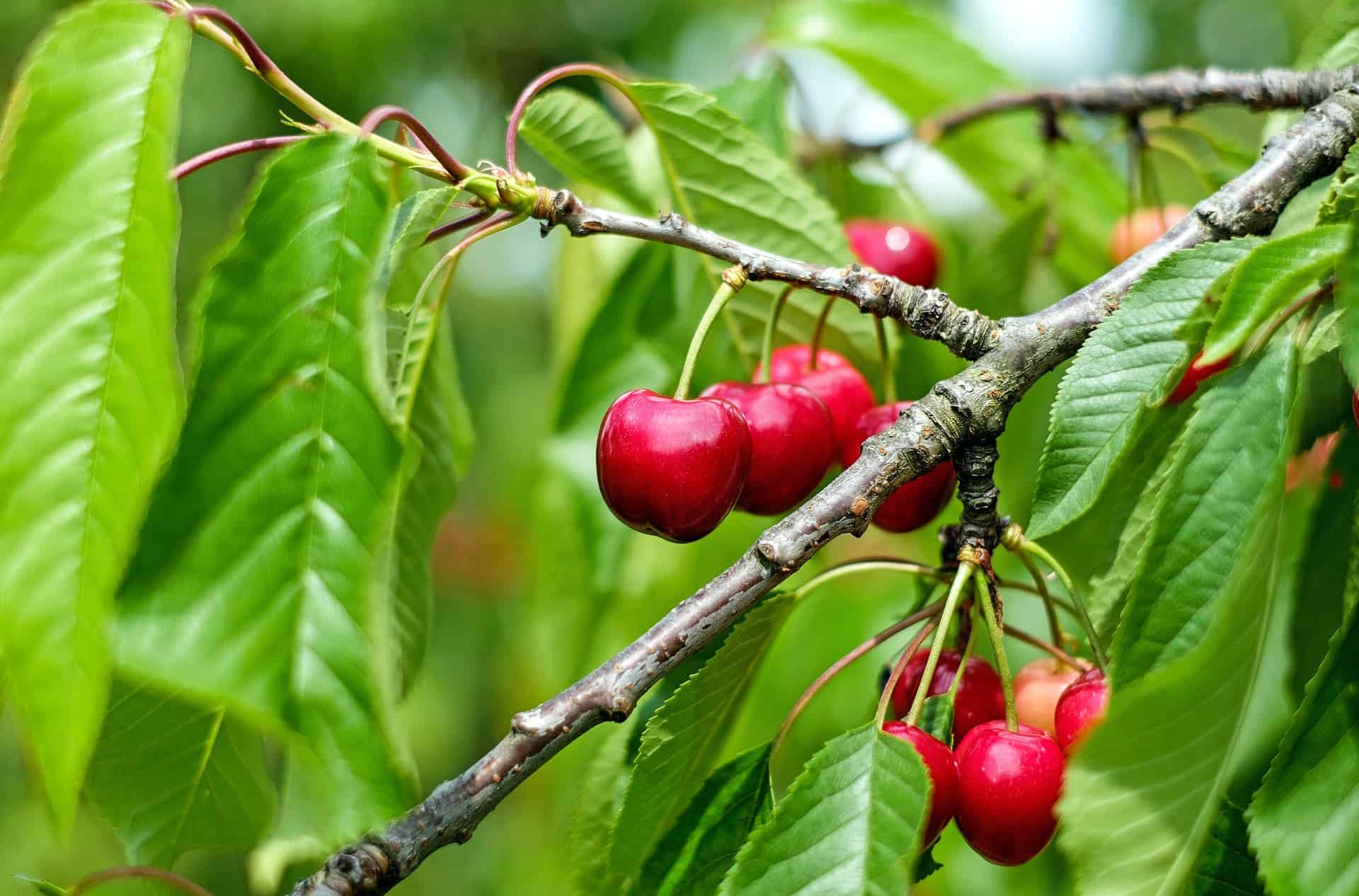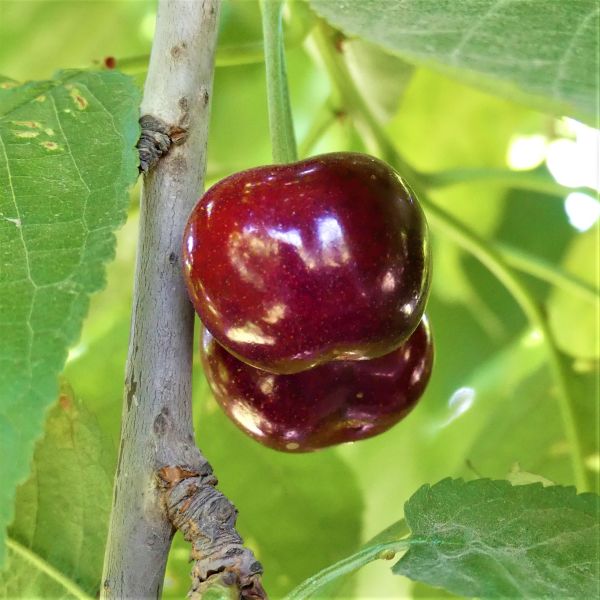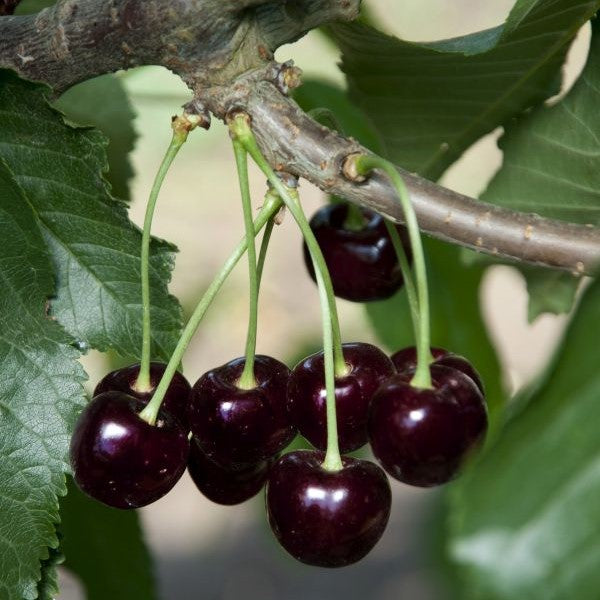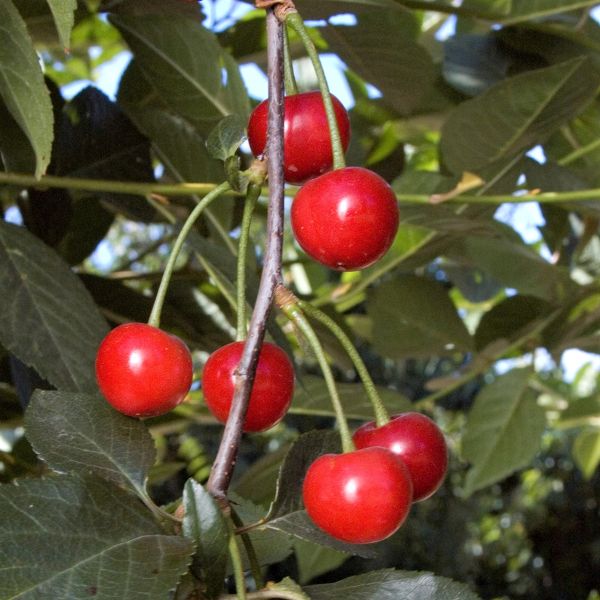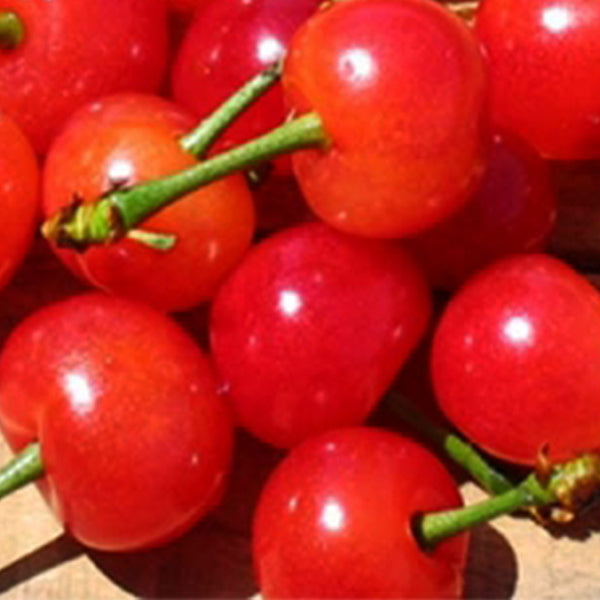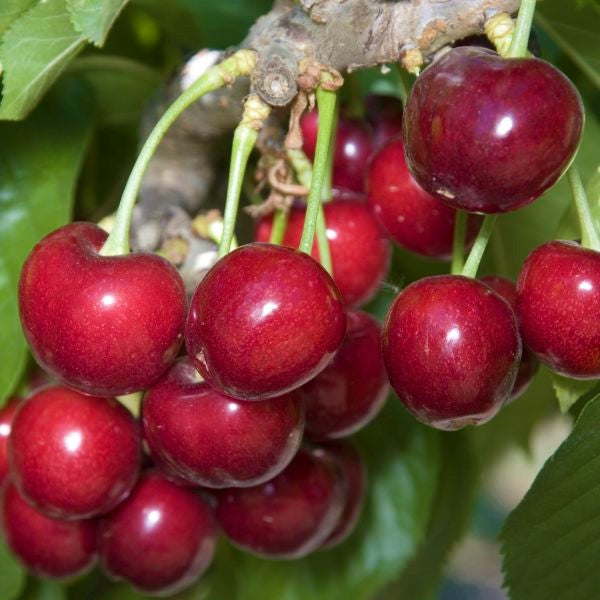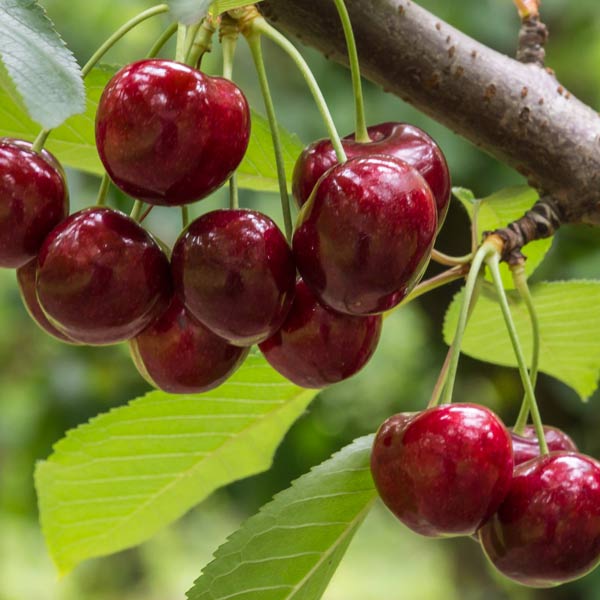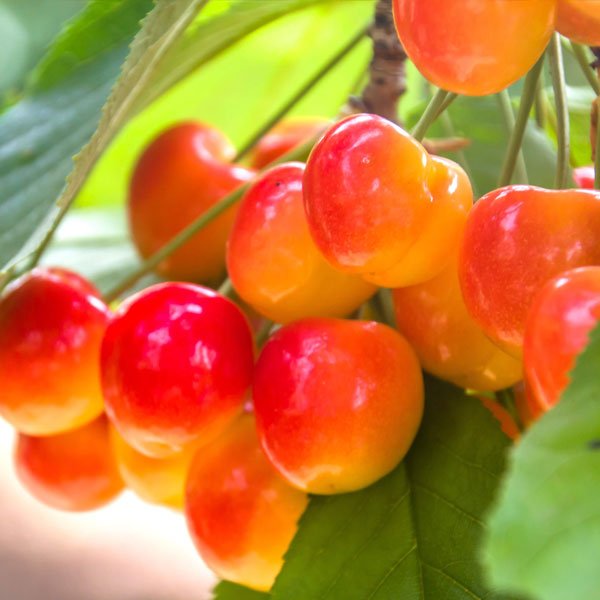We have a wide assortment of Cherry Tree Varieties that you can grow in your garden. Keep reading and you’ll even find many different types of cherry trees that produce fruits in a wide range of different shades and colors.
You can even find some of the best sweet cherry trees which are perfect for desserts, and sour cherries that have unique health-promoting properties.
Cherry Tree Varieties
Meteor Sour Cherry Tree
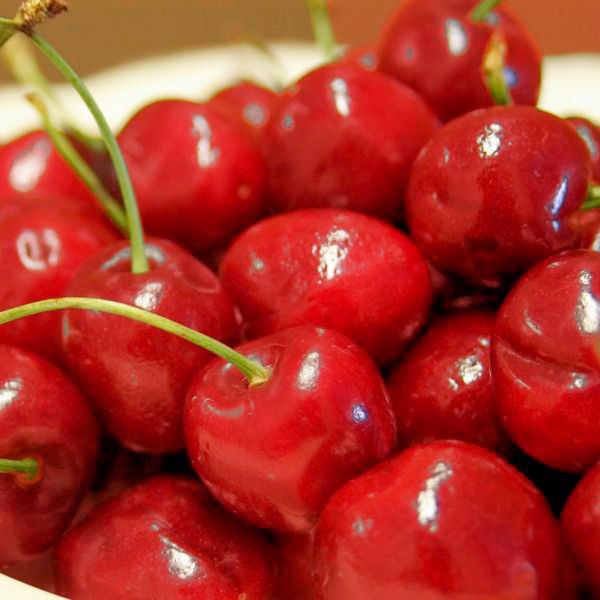
Meteor Sour Cherry Tree – (Buy Online)
The Meteor Cherry Tree (Prunus cerasus ‘Meteor’) produces fantastic tart cherries with dark red skin and yellow flesh. But this tree offers many more features than the pretty fruit. Meteor is a beautiful, hard-working fruit tree that stays small enough to fit almost any sunny spot in your landscape. It’s also certainly attractive enough to use as a specimen—in your front yard.
These Pie Cherry trees feature a nicely rounded canopy. In spring, they are profusely covered in pretty white blossoms. Textured, thick dark foliage emerges and makes a perfect foil for the developing great-tasting fruit that reddens into a highly ornamental display. In fall, the foliage turns a wonderful mix of yellow and blaze orange. This showy little tree is truly an “ornamental edible” plant!
Meteor Sour Cherry tree was developed in Minnesota, and can withstand some of the coldest temperatures in the United States. This easy-care tree is a wonderful addition as a first foray into the popular Edible Landscape trend. After all, these days it just makes sense to include fruiting trees in your yard. And this variety stays small enough for even tiny lots. The Meteor Cherry is self-fruitful so do not require a pollinizer. You’ll have a crop with just one tree, although more fruit is developed when planted with partner trees.
Corum Sweet Cherry Tree
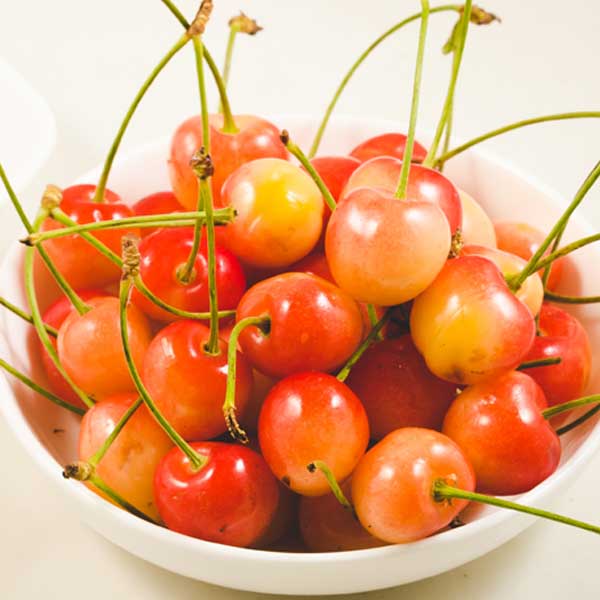
Corum Sweet Cherry Tree – Buy Online
Corum Seet Cherry Tree (Prunus avium ‘Corum’) is a productive tree that produces yellow cherries with a red blush and great flavor. Corum ripens nearly a week before Royal Ann. You’ll enjoy an extended harvest of luscious sweet cherries. The late spring bloom times overlap between these popular varieties. Plant them both for a perfect pollination partner.
Light, flavorful Corum cherries are firm enough for freezing, brining and canning. Of course, you’ll want to eat your fill of the fresh fruit. The trees are pretty enough to include in an edible landscape. And why not? People across the country are buying and growing fruiting trees—even in suburban landscapes.
This variety is well-branched and spreading. You’ll love the ornamental charm of the fragrant spring blossoms, and the developing harvest is absolutely gorgeous. Get a jump-start on those product years with this precocious variety. It starts bearing fine-quality fruit at an early age and is a valuable pollinizer for other Sweet Cherries. These vigorous trees have larger leaves than other varieties. With sturdy branches, Corum can also be used as a hard-working privacy screen.
Montmorency Cherry Tree
The Montmorency Cherry Tree (Prunus cerasus ‘Montmorency’) produces the United States most popular sour cherry. It is considered the very best cherry for making pies. This highly prized cherry tree will welcome spring with brilliant, snow-white flowers in spring, followed by a great number of clusters of red sour cherries midseason. The fruit is large-sized with bright red skin. The flesh is amber and the juice is clear.
Because it’s self-fertile only one tree is needed to produce armloads of delicious, tangy cherries. Montmorency Cherry trees can be maintained at any height with pruning. As with all Sour Cherry Trees, it has a beautiful shape for a featured spot in the landscape. It is extremely winter-hardy and heavy bearing. You will not be disappointed with this outstanding sour cherry. Grow the Montmorency cherry; it is the standard by which pie cherries are judged.
Bing Cherry Tree
The Bing Cherry (Prunus avium ‘Bing’) is positively one of the finest and most famous of the sweet cherry varieties. A cross between the Black Republican and an unknown parent, the variety was discovered in the orchards of Seth Lewelling of Milwaukie Oregon and has been adored ever since! In early spring, Bing Cherry will be positively glowing when it is covered in dazzling white flowers.
Later in the spring and during the summer, the Bing Cherry will have bright green leaves, a wonderful contrast to the deep garnet, almost-black fruit. Bing produces is a very large, dark, delicious, cherry with smooth, glossy skin and has set the standard for flavor for over 100 years. The fruit is firm, extremely juicy and has what has become the classic, rich, sweet cherry flavor. The Bings commercial success is also based on its heavy production.
Dependable year after year come mid-season, the Bing’s crop of large Sweet Cherries is always abundant. Bing is a perfect cherry for use in baking and preserves. However, your family and friends will not be able to resist eating these mouth-watering juicy cherries right off the tree. High in anti-oxidants, the Bing Cherry is a refreshing, healthy snack on a hot summer day. The Bing Cherry does require cross-pollination, so another Cherry tree is needed to produce fruit. Many cherry varieties will act as pollinators for the Bing, a few we recommend are the Lapins and Black Tartarian which are the traditional pollinators.
Lapins Cherry Tree
The Lapins Cherry is a cross between the Van and Stella Cherry. It produces some of the largest and juiciest of the sweet cherries and provides multi-seasonal interest. In early in the season, your Lapins Cherry will be smothered in brilliant white blossoms. Then, midseason, you’ll be delighted by an abundance of sweet, large, dark red to purple fruit with light red flesh. Lapins cherries are self-fruitful, and do not require a pollinator to set fruit in most regions.
They are considered the number one pollinator for the Bing in most areas and is a great universal pollinator for other cherry trees. The Lapins fruit is firm and so big that one cherry is a mouthful. The flavor is divine, incredibly juicy, and sweet. They are delicious right off the tree and wonderful for baking. You’ll be pleased to learn that these have been bred to resist splitting. In the fall, your Lapins Cherry tree will develop a beautiful orange, red, and yellow fall color.
Stella Cherry Tree
The Stella Cherry Tree is a compact, self-fruitful tree which produces an abundance of heart-shaped, shiny, black red fruit with red flesh. Its tight, upright character makes it an ideal choice for the home garden. Red-pink blooms emerge in the early spring to be followed midseason by clusters of shiny, red-black fruit on a compact tree covered in bright green foliage.
You can use the Stella as a single specimen or create a home orchard with 2 or more. The Stella produces cherries that are especially sweet, plump and firm. They resist the cracking that you see with some cherry varieties and produce well, so you’ll have lots of cherries to eat and share. Stella cherries are excellent when eaten fresh, baked into pies, made into jellies and preserves, and various other dishes. They also store and freeze well.
The Stella Cherry tree is self-fruitful but is an excellent pollinator to other cherry trees as well. They are precocious, which means they bear fruit at a young age, so you won’t have long to wait for your first harvest. Even your wildlife will thank you for adding one to their habitat… although you may have to fight the birds from time-to-time for your harvest. Stella’s compact habit makes it easy to maintain the tree’s height for making bird netting a breeze. Order one for your garden today!
Sweet Cherry Pie Cherry Tree

Sweet Cherry Pie Cherry Tree – $0.00
Just imagine a sweet cherry pie from the fruit you picked from your own tree in your own yard? ‘Sweet Cherry Pie’ makes that possible in even the smallest yard as far north as zone 3! Your ‘Sweet Cherry Pie’ cherry tree will have branches bending from the weight of all the fruit that they bear for you in the summer.
Said to be one of the Sweetest of the Sour Cherries, they are stellar for jams, jellies and pies. These are easy to grow fruit trees and you will be thrilled with the crop you get each year. Sweet Cherry Pie’s dependable consistency ensures fruit year after year.
This new selection was only recently introduced out of Wisconsin and is fast gaining popularity in all cold climates. The lush foliage and production of amazing cherry blossoms every spring make the Sweet Cherry Pie a great focal point. All this little tree really needs is good soil and full sun. It will even bear fruit for you in your favorite large pot on a sunny balcony, so enjoy this beauty in the city, too.
Rainier Cherry Tree
You won’t want to miss growing the early-bearing, precocious Rainier Cherry (Prunus avium ‘Rainier’) in your backyard orchard. This is an outstanding sweet cherry tree that produces large, delicious yellow fruit with a beautiful dark red blush. Rainier is one of the world’s sweetest yellow cherries and is in high demand by home gardeners. No wonder, as this low-maintenance tree is easy to grow. It’s often called a “white cherry” for its creamy, white flesh, or a “blond cherry” for its yellow skin that’s blushed red.
Rainier is prized for its exceptionally sweet fruit. It is often considered the best yellow cherry ever developed and is even considered by some to be the best of ALL Cherry tree varieties. The tree starts bearing fruit at a young age. Plan to start enjoying your delicious harvest in mid-season, when other garden treats are just getting started.
The thin-skinned fruit typically has a very high sugar content, measuring in at 20 to 25 Brix rates. These are much higher sugar levels than the Bing Cherry or other red Cherry tree selections.
Rainier is a pretty, upright Cherry tree. It looks lovely in fruit, flower, and fall color. You’ll adore the pastel spring blooms almost as much as the cherries. The pink-tinted, white blossoms are beautifully displayed upon the bare limbs before leaves emerge. The red fruit makes a wonderfully ornamental display, as well as a delicious crop. In autumn, Rainier puts on another show when its foliage transitions to spicy tones of bronze and yellow.
Van Cherry Tree
The Van Cherry Tree (Prunus avium Vanâ) has a well-deserved reputation as one of the finest cherries for the home grower. It’s among the cold hardiest of cherries and comes with the added bonus of its striking ornamental features. Growers appreciate its shiny, serrated leaves and its upright, rounded form, making it a visual delight for both the front yard or the mini orchard.
The Van Cherry Tree provides a beautiful display each spring when it becomes weighed down in clusters of lovely snow-white flowers, creating a show for the neighborhood that’s bound to garner a compliment or ten. The green foliage is contrasted by the rich red cherries that hang by the handful, tempting you to reach up and grab a filling and sweet-tart snack. Fruiting generally occurs by mid-June on this a late mid-season variety.
Van Cherries are sweet, shiny, and red-black in color. They resist cracks, so your harvest is bigger and more bountiful. The fruit is outstanding eaten fresh off the tree or can be used for jellies, jams, pies or preserves. Van cherries also freeze well, so you can preserve part of your crop for use later on in the year. Dry any added cherries to add to a trail mix or snack mix
Black Tartarian Cherry Tree
The Black Tartarian Cherry is a beautiful looking tree that provides excellent fruit and acts as an excellent pollinator for many cherry varieties. You can plant several cherry varieties and enjoy an extended summer harvest.
Black Tartarian is an old variety of cherry tree that has remained a favorite among homeowners for the pollination it provides many cherry varieties as well as the superior fruit and dependable high yields.
If you’re looking for a pretty tree that will provide years of delicious fruit with little effort, then the Black Tartarian is for you. Remember though, that one of the best features of your Black Tartarian is its outstanding fruit. Beginning in the spring this cherry tree will come alive with an abundance of white, fragrant flowers. The clusters of 5-peteled beauties veritably cover the branches with their pristine splendor.
You’ll be amazed by the number of butterflies who have come to dance among the blossoms. It’s a beautiful experience of nature in all her glory! As the flowers fade, the Black Tartarian will fill out with shiny green leaves and begin to form the fruit that your tree is most prized for. By early to mid-summer, you’ll be able to pause under your tree’s canopy and reach up for a sun-warmed, sweet snack that will tantalize your taste buds.
The Black Tartarian cherry is about 1-inch in size with a deep purple hue. The flesh is dark red, dense, and very juicy. The stone comes loose easily from the cherry, so even if you’re pitting the cherries for use in a culinary dish, you won’t have to work very hard.
The Black Tartarian is hardy and disease resistant, tolerant of most conditions, and easy for even the novice gardener to grow. Considering the stellar benefits of the Black Tartarian Cherry tree, you won’t want to miss including at least one of these in your own home orchard.
English Morello Cherry Tree
The English Morello is an ornamental tree that produces delicious fruit. Plant several for a small orchard on a side yard, or perhaps a few along your driveway for an elegant welcome to your home all summer long. You can even use the English Morello as a small hedge, as they adapt well to pruning.
When the pretty flowers of many cherry trees have faded in decline, you can count on your English Morello to begin its dazzling display. In fact, you can easily prolong your summer cherry harvest as well by planting a few of these late-ripening trees. Mid-summer is sure to bring you a prolific harvest of delicious, tart cherries that are perfect for many uses.
Bake a pie for the neighbors or perhaps keep a bowl on the kitchen table for enjoying fresh. English Morello cherries are outstanding for canning or freezing and maintain their flavor well. They’re also perfect for liquors and brandies, creating wonderful home-grown holiday gifts. This late-blooming self-fertile tree produces prolifically, with clusters of dark red fruit that mature in mid-summer.
Early Richmond Cherry Tree
The Early Richmond Cherry Tree (Prunus cerasus ‘Early Richmond’) is prized by growers for its high yields and its beautiful ornamental qualities. The Early Richmond puts on a show each spring, with its profuse bloom of abundant white flowers. Glossy, dark green foliage fills the tree out for the summer, providing a contrasting backdrop for when it begins to hang heavy with red cherries, warmed by the sun and ready for eating.
Known to ripen up to a week earlier than other cherry trees, the Early Richmond offers a bounty of sour cherries in the late spring. While you may be tempted to eat them straight from the tree by the handful, the Early Richmond is also ideal for cooking, canning, and preserving. The tart flavor is just the thing for classic cherry pie, or use it in cobblers and dessert sauces. Nothing’s better than homemade jams and preserves from your very own cherry tree.
This hardy fruit tree is an ideal addition to properties in Zones 4-9, where it adapts well to soil conditions ranging from moist to well-drained. A semi-dwarf variety, the Early Richmond takes up less space in your yard or orchard than its average-height cherry cousins, making it a good choice if you have limited space available for planting.
Sweetheart Cherry Tree
A Sweetheart Cherry Tree will create a spectacle in your yard once friends and neighbors have sampled its delectable fruit. What’s incredible about this cherry is that it ripens over a period of a couple of weeks, so your harvest season is extended…and what a harvest it is!
The shiny, bright Heart-shaped red fruits exterior covers the smooth, crisp skin of this exquisite cherry. The interior flesh is meaty and firm, but with a deliciously sweet flavor that will make your taste buds water. A slight hint of acidic undertone is just enough to provide the perfect amount of bite to this unique cherry. It even remains crisp long after being picked.
Sweetheart Cherry is not only a source of wonderful fruit but also a lovely tree for your yard and can be pruned to maintain almost any height. Mid-April brings pristine white flowers which results in a late harvest of mid-July cherries that dot the tree-like tiny, brilliant ornaments amid the green foliage. Autumn transforms the shiny foliage to shades of orange, pink, or red for yet another decorative show. Of course, as with most cherry trees, even the bark itself is lovely. The reddish, dark-brown hue even becomes fissured on older trees for added interest.
Utah Giant Cherry Tree
The Utah Giant Sweet Cherry (Prunus avium Utah Giant’) is one of the top-performing Sweet Cherry trees for incredible flavor. The trouble sometimes is by the time the stores get them they get harvested, stored, packaged, and shipped all across the country, they do not always taste so great. Why not pick them fresh from your tree and sample that award-winning flavor?
Utah Giant is a mid-season bloomer that will need to cross-pollinate with another Sweet Cherry that blooms at the same time. Some pollinator partners are Bing, Black Tatarian, Rainier, and Van Cherry varieties. By mid-season, you’ll be harvesting those mouth-watering, firm Sweet Cherries! The flesh color is dark red and oh-so-sweet. Just pick right off the tree and enjoy fresh or can them to enjoy later. Utah Giant is a great Western disease-resistant variety.
Lambert Sweet Cherry Tree
The Lambert Sweet Cherry Tree (Prunus avium ‘Lambert’) is a wonderful addition to the home garden. You’ll love the look—and the taste—of these large, firm cherries. Deep, dark red, and heart-shaped, Lambert are excellent fresh eating sweet cherries. Capture the incredible taste by canning them for use later in the year.
Lambert Sweet Cherry is a pretty tree in its own right. With lovely spring blooms and the knockout, deep, dark fruit set, you’ll always have something to study and appreciate. Trust us, you might even find yourself getting giddy with anticipation of your annual crop! Plant a group of 2 or 3 varieties that will pollinate each other and extend the harvest season. Van, Black Tartarian, and Rainier will all work to pollinate Lambert.
Royal Ann Cherry Tree
Royal Ann Cherry Tree (Prunus avium ‘Royal Ann’) has graced orchards for over 175 years! With firm flesh and a bright, sweet taste, this time-tested favorite has earned a spot in your backyard orchard. These semi-dwarf Cherry trees grow with an upright form. Add in the gorgeous spring flower display, and the Royal Ann tree can be used as a lovely ornamental in its own right.
Site it anywhere in your edible landscape with pride. You’ll love having a big supply of homegrown sweet cherries for fresh eating. Growers report harvesting up to 50 pounds of fruit, even from young trees. Luckily, blonde Royal Ann cherries are firm enough to withstand canning for enjoyment later in the season.
While Royal Ann cherries look like Rainier cherry variety, there are differences. Both are sweet Cherry trees, but Royal Ann is better suited for winter temperatures. They are also said to be more aromatic. Cocktail gourmands can try their hand at making a healthier—and tastier—maraschino cherry with the large fruit.


